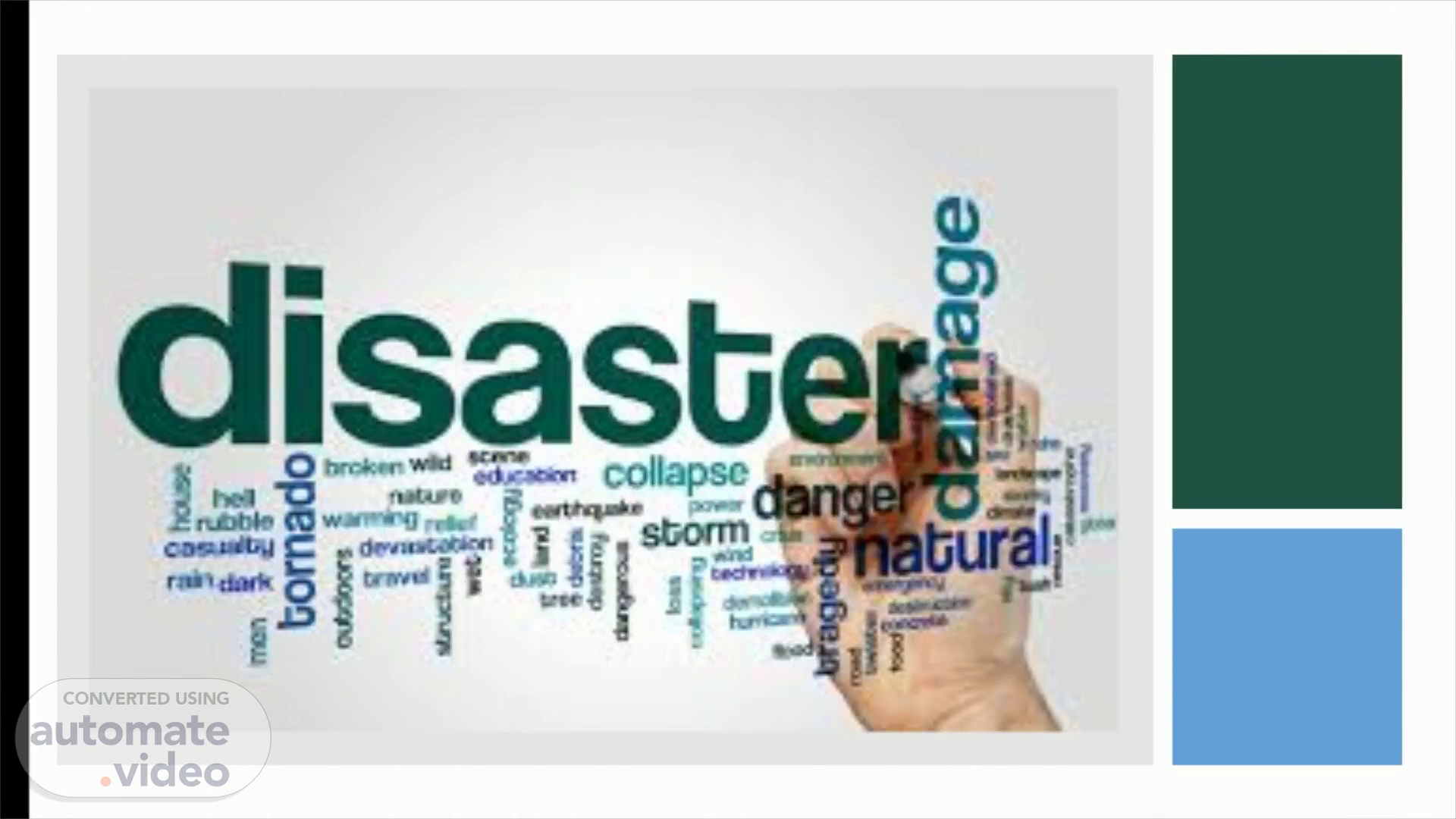
PowerPoint Presentation
Scene 1 (0s)
disasbe.
Scene 2 (8s)
MADE BY. 2103255 Saksham Gupta.
Scene 3 (17s)
DISASTER MANAGEMENT The United Nations defines a disaster as a serious disruption of the functioning of a community or a society. Disasters involve widespread human, material, economic or environmental impacts, which exceed the ability of the affected community or society to cope using its own resources. The Red Cross and Red Crescent societies define disaster management as the organization and management of resources and responsibilities for dealing with all humanitarian aspects of emergencies, in particular preparedness, response and recovery in order to lessen the impact of disasters..
Scene 4 (41s)
What is Disaster Management? Preparedness activities prior to a disaster. Prep. e Examples: preparedness plans; emergency 00 exercises/training; warning systems. Response activities during a disaster. Exarnples: public warning systems; emergency operations; search and rescue. Recovery activities following a disaster. Exarnples: temporary housing; claims processing and grants; long-term medical care and counseling. Mitigation - activities that reduce the effects of disasters. Examples: building codes and zoning; vulnerability analyses; public education. o ISAsrER esuo.
Scene 5 (1m 4s)
Types of Disasters Natural Man-Made Complex nd Pri sunw- Pandemic emergencies.
Scene 6 (1m 13s)
TYPES or DISASTER Natural disasters: including floods, hurricanes, earthquakes and volcano eruptions that have immediate impacts on human health and secondary impacts causing further death and suffering from (for example) floods, landslides, fires, tsunamis. Environmental emergencies: including technological or industrial accidents, usually involving the production, use or transportation of hazardous material, and occur where these materials are produced, used or transported, and forest fires caused by humans. Complex emergencies: involving a break-down of authority, looting an attacks on strategic installations, including conflict situations and war. Pandemic emergencies: involving a sudden onset of contagious disease affects health, disrupts services and businesses, brings economic and costs..
Scene 7 (1m 44s)
0JAPAN China Russia N. rea Sapporo Honshu okkaido J apara Sea of Japan (East Sea) okyo goya Shikoku Yo ohama North Pacific.
Scene 8 (1m 54s)
TSUNAMI DISASTER MITIGATION SYSTEM IN JAPAN 1. Bitter Tsunami Experienced 2. Tsunami Warning and Mitigation System 3. Outline of Disaster Management System 4. New Challenges against Tsunamis earthquake TYPES OF DISATERS IN JAPAN Volcanic tsunanni eruption 1.
Scene 9 (2m 7s)
HISTORICAL DAMAGING TSUNAMIS ALONG JAPANESE COAST (IN LAST 150 YEARS) Name (Magnitude) Meiji-Sanriku Earthquake and Tsunami (M8.5) Showa-Sanriku Earthquake and Tsunami (M8.1) Tonankai Earthquake (M7.9) Nankai Earthquake (M8.0) Chile Earthquake (Mw9.5) 2) Tokachi-Oki Earthquake (M7.9) Nihonkai-Cyubu Earthquake (M7.7) Hokkaido-Nansei-oki Earthquake (M7.8) Year 1896 1933 1944 1946 1960 1968 1983 1993 Dead or Missing 22,000 3,064 1,251 1) 1,443 1) 142 52 1) 230 1) 8.
Scene 10 (2m 28s)
TSUNAMI WARNING SYSTEM ELEMENTS Communication & Transmission of Tsunami Warning to Localities & Civil Defense Authorities TSUNAMI WARNI Local government Central Government WARNI T V / Radio Station Signboard io l/ TV (Telops, Warning maps) 13.
Scene 11 (2m 41s)
PICTOGRAM ON TSUNAMI Tsunami Hazard Area There is a high possibility to be flooded in this area when earthquake occurs. Tsunami Evacuation Area Safe place/hill for evacuation against Tsunami. Tsunami Evacuation Building Building for evacuation against Tsunami..
Scene 12 (2m 55s)
TSUNAMI COUNTER MEASURES TAKEN BY LOCAL MUNICIPALITIES AND COMMUNITIES Vacuation drill on unaml aro Town, Iwate Pref. yupplying a-City, Eh ref,).
Scene 13 (3m 7s)
TSUNAMI HAZARD MAPS Purpose - Identifying and showing vulnerable areas - Enhancing people's awareness • Showing information on disaster risks and evacuation routes, etc. • Letting residents in coastal areas and visitors know the hazard map through various opportunities • Tsunami drills Tsunami Hazard Map (Sus 1 Ity National Government prepared a guideline for help local authorities to make and use hazard maps. 28.
Scene 14 (3m 26s)
THANK YOU.